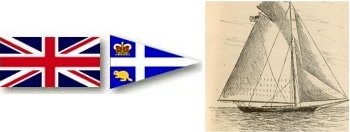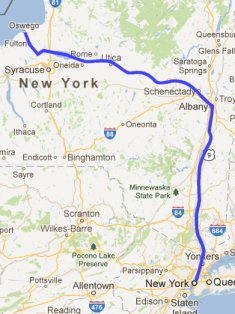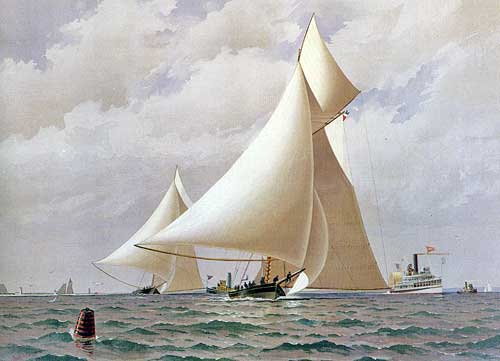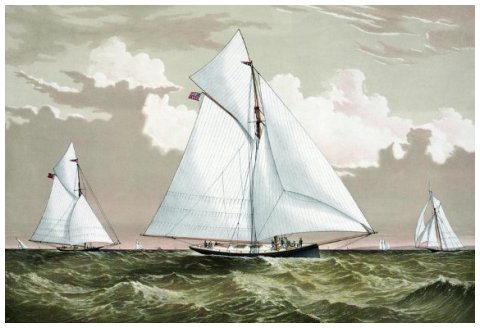Yves GARY Hits: 5717
Category: ATALANTA
 Unsuccessful challenger for the America's Cup series of 1881
Unsuccessful challenger for the America's Cup series of 1881The Atalanta was designed, modeled and built by Captain Alexander Cuthbert of Coburg, reportedly at a cost of $2,100 [C.H.J. Snider], as an improvement to his Annie Cuthbert. Launched late (17 September 1881) the Atalanta was not finished.
 Her planking was not planed down and her fittings were almost unfinished. Money was lacking and work had stopped several times to wait for cash. When the boat sailed down the Bay of Quinte, the crew were still nailing down her deck and other fittings. The suit of sails was brand new, ill-fitting and the cotton duck had not had time to lose its nap.
Her planking was not planed down and her fittings were almost unfinished. Money was lacking and work had stopped several times to wait for cash. When the boat sailed down the Bay of Quinte, the crew were still nailing down her deck and other fittings. The suit of sails was brand new, ill-fitting and the cotton duck had not had time to lose its nap.
Due to this delay, Atalanta had had no time to sail the St. Lawrence-ocean course to New York if she was to reach the venue in time. Instead, she was forced to take the short route entering the Erie Canal at Oswego. But the beam was too wide for the locks, the crew shifted ballast to one side to heel her over. Then a team of mules towed her and the boat got the nickname of "The Canadian Mud Turtle".
When Atalanta reached the Albany end of the Canal, the crew shifted the ballast back, stepped the mast and set sail for New York harbour arriving on October 30th, 1881. The same day, the NYYC began preparations for the challenge races planed for November.
Many of the crew promised from Belleville didn't come to join Atalanta. In a hurry, the team was complimented by a number of amateur sailors from the Oswego Yacht Club, and possibly some "Norwegian steam" in New York. Some last minute modifications were made - shortening the mainmast and re-cutting some sails.

The series was planned as a "best of three" against Mischief (designer: Archibald Cary Smith, 1837-1911, built by Harlan & Hollingsworth of Wilmington, Delaware in 1879 for English owner Joseph Richard Busk of the New York Yacht Club.) Nicknamed "The Iron Pot", she was skippered by Nathanael "Than" Clock during the series.
 First race:
First race:
8 Nov., Mischief named as defender, race cancelled due to fog and light air.
9 Nov., 1st race, 32.6 miles, "inside course" (triangle), fresh Sou'Wester: Atalanta started reefed, added then struck tops'l, shook out reef, added then struck tops'l; Mischief started with a full main then shortly added her tops'l; both boats set and struck a balloon jib top on the downwind leg.
Mischief beat Atalanta by 28 minutes 20.25 sec on corrected time (she had a 2 minute 45 seconds time allowance.)
Second race:
10 November, 2nd race, 32 miles, "outside course" (leeward windward): Atalanta did fairly well downwind, losing only 2 min 15 secs at the leeward mark. As to sail changes Atalanta started with her tops'l and reefed main, Mischief with a working tops'l and full main; both set a balloon jib tops'l, but Atalanta broke her pole; both housed their topmasts for the return leg, Atalanta double reefed, Mischief single reefed.
Mischief beat Atalanta by 38 minutes 54 sec on corrected time (same allowance.)
Result: Mischief beat Atalanta two wins to nil.

 The poor sailing of Atalanta forced the NYYC to change the Deed of Gift so that the challenger should belong to a yacht club situated on an arm of the sea, thus excluding the freshwater Great Lakes, and had to sail on her own bottom to New York.
The poor sailing of Atalanta forced the NYYC to change the Deed of Gift so that the challenger should belong to a yacht club situated on an arm of the sea, thus excluding the freshwater Great Lakes, and had to sail on her own bottom to New York.
It is possible to conclude that the Atalanta lacked preparation and crew training. The state of her bottom and sails left much to be desired. It might also be said that under the right weather conditions she could have been much more competitive, if not a winner (c.f. her later successes on the Great Lakes.) She and Pocahontas were the first yachts ever designed and built specifically for the America's Cup -- the latter at nearly ten times the cost.
1882 : Atalanta was sailing on Lake Ontario.
1883 : The sloop sailed to Chicago to race in the Fisher Cup. She was leading the race when she broke her spinnaker boom and was beaten by Cora. After completing the repairs, Cuthbert beat Cora by 16 minutes, during a private match on the same course, and took back the Fisher Cup to Bay of Quinte. Atalanta held the trophy until 1886.
1896 : Atalanta was partly burned. Sold and taken to Chicago where the sloop was rebuilt with higher topsides and flush decks.
1900 : Atalanta was last seen in New Orleans.
